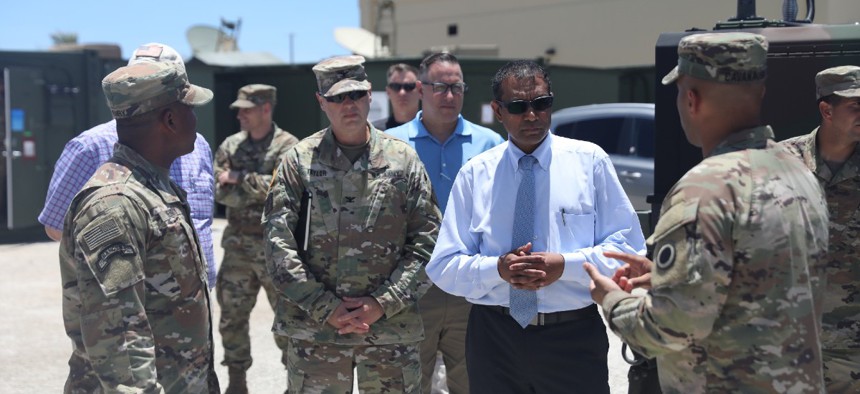
Leaders of the U.S. Army Pacific welcome Dr. Raj Iyer, chief information officer for the U.S. Army, to show the capabilities of USARPAC in Forager 21 at Andersen Air Force Base, July 28, 2021. Richard Mohr/Army
Army Gets Strategic About Going Digital
Policy reforms and technology boosts are in the pipeline, military leaders confirmed.
The newly crafted Army Digital Transformation Strategy, or ADTS, marks a key component of the branch’s overarching modernization efforts that is meant to reform policies, advance technical capabilities and prepare personnel for the next era of conflict, senior defense officials confirmed.
Army Chief Information Officer Dr. Raj Iyer announced the creation and impending release of the multi-year plan at the annual Association of the U.S. Army meeting in Washington on Wednesday. The strategy aligns with a broader culture and mindset shift, according to him, and is intended to transform the Army into a technology-driven, multi-domain operations force by 2028.
“We're moving from the industrial age to the digital age—the chiefs call it the ‘information age.’ And what this means is, now, us pivoting towards data for decision-making, right? They'll always have platforms. They’ll always have [information technology] systems and they’ll always have the networks,” Iyer explained. “But what's new now, and what's different now, is our pivot to using data as our strategic asset for decision-making.”
On the heels of the United States withdrawal from Afghanistan, the military is embarking on a strategic reset, and reprioritizing operations to adjust to nascent combat scenarios that are increasingly based in cyberspace. This new strategy will support the Army as it adapts, but it also builds on explicit calls made via the branch’s modernization strategy, released in 2019.
Speaking alongside several other Army executives, Iyer noted that money is not an issue when it comes to the enterprise’s future-facing revampment aims—he oversees a $15 billion annual IT spending budget. A unified strategy is the primary necessity to align resources and balance priorities.
The ADTS is organized around three objectives, Iyer confirmed.
Finding a balance between “modernization and readiness” is the first of those. Achieving that pillar will involve divesting in legacy systems and paving the way for a digitally-savvy and data-driven organization. The second objective is “reform.”
“Our policies haven't changed in 30 to 40 years. I was surprised to go back and look at some of our cybersecurity policies, data policies and network policies. You know, it is not reflective of what we need to do to achieve multi domain operations—and my job as the CIO in the secretariat is to fix those policies,” Iyer explained. “I don't want to do this in a vacuum. I want to make sure that we do this the right way. So I'm seeking and looking for your feedback in terms of where policy is an impediment to you.”
The strategy's third objective, “people and partnerships,” prioritizes strategically upskilling employees to ensure they are prepared for this nascent, digital age and collaborating with industry and academia.
In a conversation with Nextgov after the panel, Iyer expanded on elements of this goal.
He sees reskilling and upskilling staff so that they can take full advantage of virtual tools in the pipeline as “critical” pursuits going forward. The Army has already “created capacity” training some employees in software-related topics, but how it approaches doing that in the future will likely be altered. According to the tech chief, the branch is churning out cadres of 25 soldiers with new skills from software factories roughly every six months.
However, often when they return to their typical work in their specific units, they simply go back to completing their previous functions.
“We have not taken advantage of the new skills that they've learned, right?” Iyer said. “So the Army is changing our doctrinal concept for how we're going to be coding at the edge and [using artificial intelligence] at the edge. And all of those have to mature before we can establish the right capacity that we need, in terms of how many of these soldiers we need to generate.”
Among other topics addressed at AUSA, Iyer and others on the panel also emphasized that cybersecurity would be moved to the “front and center” of this transformation process—and how they generally operate moving forward.
“We are at an inflection point,” Army Deputy Chief of Staff, Lt. Gen. John Morrison said.
Iyer said the strategy would be released at the end of AUSA, which closed on Wednesday.
“The Army Digital Transformation Strategy is in the final staffing processes and will be released once approved,” an Army press officer told Nextgov on Thursday.
Editor's note: This story was updated to include details on the strategy's release.




